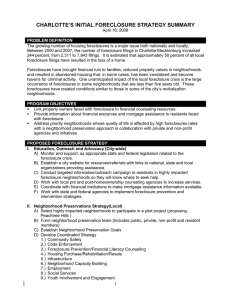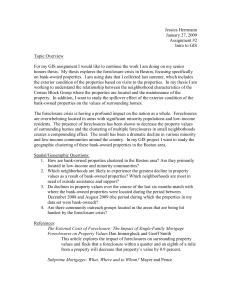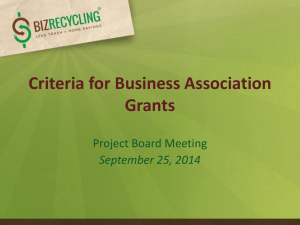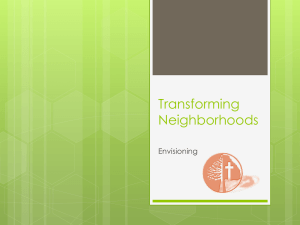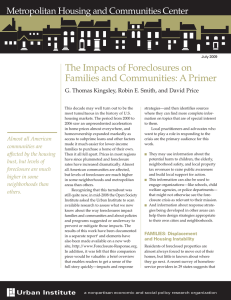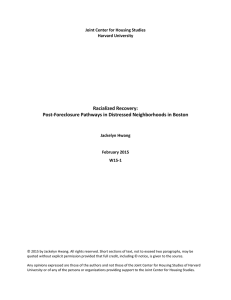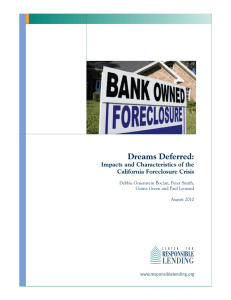PPT
advertisement
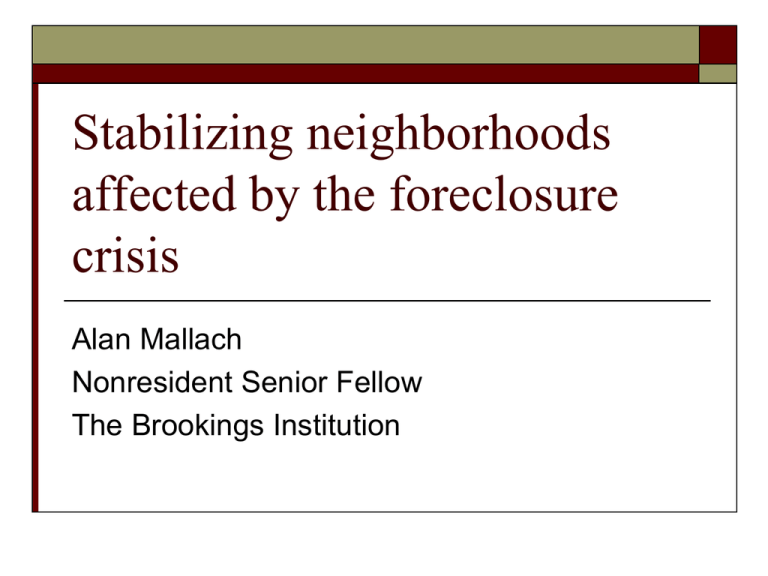
Stabilizing neighborhoods affected by the foreclosure crisis Alan Mallach Nonresident Senior Fellow The Brookings Institution What is neighborhood stability? A stable neighborhood is one where residents and potential buyers feel confident that their investment – psychological as well as financial – is secure Key physical, social and economic variables promote neighborhood stability by preserving/enhancing residents’ and buyers’ investment in their neighborhood. Key variables affecting stability Vacancy and abandonment Level of property investment Poverty concentration Home ownership rate Crime Figure 4.3: The relationship between home ownership and house values in Trenton NJ 120 Median value of owner-occupied housing ($000) 100 80 60 40 20 0 30 40 50 60 70 % of single fam ily houses ow ner-occuped 80 90 100 Destabilization takes place when changes take place that reduce resident and buyer confidence in their neighborhood Negative changes in any of these variables can trigger neighborhood destabilization. All of these variables are powerfully affected by foreclosure – particularly the link between foreclosures and vacancy Foreclosures are sweeping the country Center for Responsible Lending projects nearly 2.2 million subprime foreclosures from mid-2008 through the end of 2009. Credit Suisse projects 6.5 million total foreclosures by the end of 2012. No one yet has taken full account of the potential impact of a deep, prolonged recession on foreclosures. Foreclosures destabilize cities and neighborhoods Foreclosures significantly reduce the value of neighboring properties Increased foreclosures can lead to increases in violent crime in the vicinity Foreclosures impose significant costs on local governments These effects are less the product of foreclosure as such, as the result of the link between foreclosures and vacancy. Neighborhood effects of foreclosure are uneven Foreclosure effects are unevenly distributed geographically Foreclosure effects vary based on legal process and market conditions Northside Phillips Central Market correction Market destabilization Market collapse 1 of 8 properties in East Cleveland are REO properties – between 2005 and 2007 property values dropped by 83% Impacts are greatest in weaker markets Owners are most likely to leave before foreclosure sale Creditor is less concerned with preserving value of property Creditor may not even finalize foreclosure, leaving property in limbo. Vacant property is more likely to be stripped and vandalized. Weakest market neighborhoods are not always those most impacted by foreclosure Areas with >2 home mortgages per 100 1-4 family structures in 2005 (HMDA) Youngstown OH foreclosures 2007-2008 How to address destabilization Prevent foreclosures Reduce the link between foreclosures, disinvestment and vacancy Acquire and reuse vacant properties - Federal Neighborhood Stabilization Program Address other forces working to destabilize neighborhood – build confidence and market demand Acquisition and reuse Using the HUD Neighborhood Stabilization Program Be sensitive to market conditions Target to need, impact and capacity Leverage resources Integrate program with other neighborhood stabilization and market building efforts Good data is essential Identifying target areas Understanding market dynamics of target areas Identifying level/type of market activity Identifying potential target markets Defining strategies and making critical decisions around target properties Acquisition Rehabilitation or demolition Reuse for owner-occupancy or rental Short-term reuse or land banking Identifying most valuable complementary strategies Monitoring progress and evaluating outcomes Indicators can help establish neighborhood market character Areas with <2 home mortgages per 100 1-4 family structures in 2006 (HMDA) Market conditions should drive strategy Market correction Little or not acquisition - allow the market to correct itself Market destabilization Acquisition to create opportunities for reuse and neighborhood stabilization Market collapse Acquisition to land bank for future opportunities Market conditions should drive strategy Market correction Market destabilization Market collapse Foreclosure prevention Code enforcement Selective rehabilitation for homeownership or rental Demolition Interim uses Foreclosure prevention Code enforcement Rehabilitation for homeownership Selective demolition Infill development Other factors are critically important Target limited resources in order to have meaningful stabilizing impact Focus on areas where conditions make impact possible Ensure that each targeted area receives enough investment to make impact possible Build on capacity to implement strategy Capitalize on neighborhood-based resources: community organizations, CDCs, anchor institutions Leverage other activities to promote stabilization and market demand Crime prevention Build neighborhood amenities and quality of life Build stronger neighborhood social fabric Build market demand Focus on outcomes In the end, neighborhood stabilization is not about the number of units acquired, rehabilitated or demolished – it is about restoring stability, in terms of healthy market conditions and resident/buyer confidence, to the city’s neighborhoods. Alan Mallach PO Box 623 Roosevelt NJ 08555 609.448.5614 amallach@comcast.net
